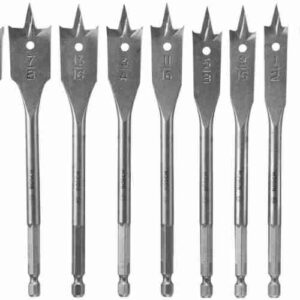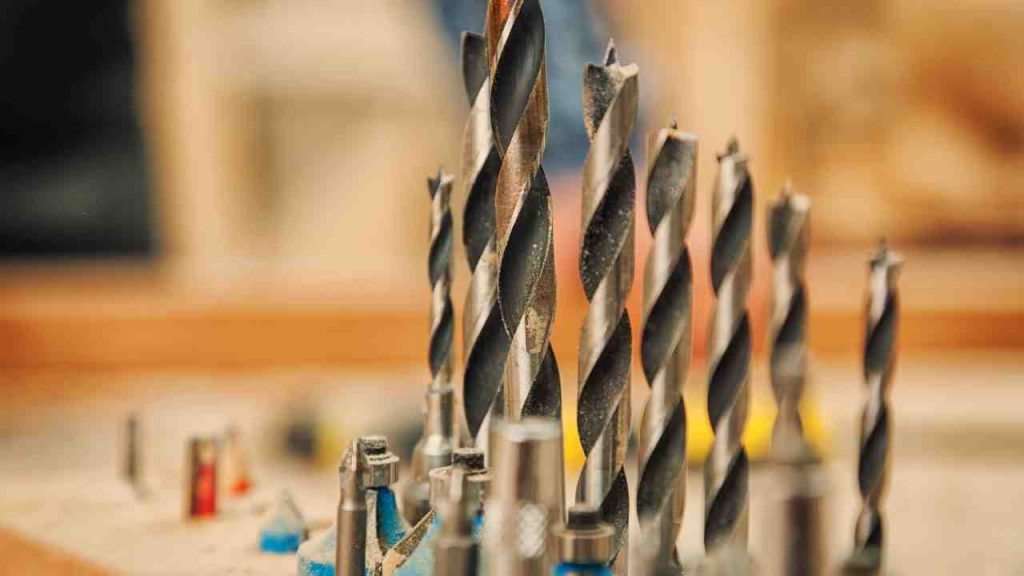Do you know the difference between drill press bits and standard drill bits? Whether you like DIY projects or dealing with wood or metal, you’ve probably come across both kinds of drill bits. Although they are the same, drill press and normal drill bits differ.
So, let’s get started! This blog article will explain what drill press bits are, how they vary from conventional ones, and when they should be used. By the conclusion of this piece, you’ll have a better knowledge of how drill press bits function and if they’re the correct option for your next drilling job.
What are drill press bits?
Drill press bits are particularly intended for use with a drill press machine. A drill press is a stationary instrument that can drill accurate holes into wood, metal, and plastic materials. Drill press bits have a longer shank that fits snugly into a drill press chuck.
 What types of bits are used on a drill press?
What types of bits are used on a drill press?
- Twist Bits: The most popular form of drill press bit, twist bits may be utilized for ordinary drilling jobs. They feature a sharp tip and two spiraling flutes around the bit. Twist bits come in several sizes and may be utilized with various materials.
- Spade Bits: They drill bigger holes in wood. They are flat, paddle-shaped, and have a sharp tip in the middle. Spade bits are available in various sizes and are excellent for drilling holes in door locks or electrical boxes.
- Auger Bits: Auger bits make deep, thin holes in wood. Their shaft is long and twisted, with a cutting edge at the tip. Auger bits come in various diameters and may be used to drill holes for dowels, pipes, and wires.
- Forstner Bits: Forstner bits make holes with clean, flat bottoms and smooth edges. They are cylindrical, with a central point and two cutting blades forming a flat-bottomed hole. Forstner bits are great for woodworking and are often used to make mortises and inlays.
- Hole Saw Bits: They drill bigger diameter holes in wood and metal. They are cylindrical and have a serrated edge that cuts a circular hole. Hole saw bits come in various diameters and may be used to cut holes in pipes, conduits, and light fixtures.
Drill press bit speed chart:
| Bit Type | Softwood (Pine) | Hardwood (Hard Maple) | Acrylic | Brass | Aluminum | Steel | |
| Twist Bit | 3000 – 4000 | 2000 – 3000 | 4000 – 6000 | 2000 – 3000 | 1500 – 2000 | 500 – 1000 | |
| Spade Bit | 1500 – 2000 | 1000 – 1500 | 2000 – 3000 | 1000 – 1500 | 1000 – 1500 | 500 – 1000 | |
| Auger Bit | 500 – 1000 | 250 – 500 | 1000 – 1500 | 500 – 1000 | 500 – 1000 | 250 – 500 | |
| Forstner Bit | 1000 – 2000 | 500 – 1000 | 2000 – 3000 | 1000 – 1500 | 1000 – 1500 | 500 – 1000 | |
| Hole Saw Bit | 500 – 1000 | 250 – 500 | 1000 – 1500 | 500 – 1000 | 500 – 1000 | 250 – 500 | |
| Glass and Tile | 3000 – 4000 | 2000 – 3000 | 4000 – 6000 | – | – | – | |
| Multi-spur Bit | 2000 – 3000 | 1000 – 1500 | 2000 – 3000 | 1000 – 1500 | 1000 – 1500 | 500 – 1000 | |
| Brad Point Bit | 2000 – 3000 | 1000 – 1500 | 2000 – 3000 | 1000 – 1500 | 1000 – 1500 | 500 – 1000 |
Drill press bits vs regular drill bits: 5 key differences
- Shape: Drill press bits are often longer and narrower in form than standard drill bits. Because of this, they may be utilized with the deeper chunks of a drill press machine. Conventional drill bits, on the other hand, are often shorter and broader in design, making them more adaptable to various drilling jobs.
- Length: Drill press bits are typically longer than standard drill bits. Because of the extra length, they can drill deeper holes without moving the workpiece or drill bit. Conventional drill bits are usually shorter and need more frequent adjustments throughout the drilling operation.
- Shank size: Unlike conventional drill bits, drill press bits are bigger. A drill press machine chuck needs a greater shank size to hold the bit. Normal drill bits feature a smaller shank size and may be used in various instruments, including portable drills.
- Flutes: The flutes on drill press bits are often longer and more prominent than those on conventional drill bits. This is due to the flutes’ ability to remove dirt while keeping the bit cool throughout the drilling operation. Since they do not need to remove as much material, regular drill bits may have shorter or shallower flutes.
- Angle: The cutting-edge angle of drill press bits frequently differs from that of conventional drill bits. Drill press bits feature a sharper angle, making them ideal for drilling accurate, clean holes. Normal drill bits may have a broader angle, making them more adaptable to drilling various materials.
How to choose the right drill bit for your next project?
- Evaluate the material: Various drill bits are designed for different materials. Twist bits, for example, are meant for drilling through wood, plastic, and metal, while masonry bits are intended for drilling through brick, concrete, and stone. Be sure you use the correct drill bit for the material you’re dealing with.
- Decide the hole size: The kind of drill bit you pick will be influenced by the hole size you need to drill. Spade bits are best for bigger-diameter holes, while twist bits are preferable for smaller holes. Consider using a Forstner or brad point bit for accurate holes.
- Evaluate the hole depth: If you need to drill a deep hole, you will require a longer bit. Auger bits and installation bits are intended for deep drilling, although twist bits may not be suited for extremely deep holes.
- Verify the chuck size: If using a drill press machine, ensure the drill bit has a shank size that fits the chuck. The chucks on most drill press machines can support greater shank diameters than handheld drills.
- Consider the finish: If you are drilling through a material that demands a clean finish, such as woodworking, a Forstner or brad point bit will provide the best results. A twist or spade bit may suffice if the finish is not critical.
Frequently Asked Questions (FAQs)
Can I use regular drill bits with a drill press?
Yes, you can use regular drill bits with a drill press. However, keep in mind that drill press bits are specifically designed for use with a drill press machine and may offer better performance in terms of accuracy and hole quality.
What type of drill bit should I use for metal?
For drilling into metal, high-speed steel (HSS) twist bits are the most common choice. They are durable and can withstand the heat generated while drilling through metal. You can also use cobalt or carbide-tipped bits for harder metals.
Can I use a Forstner bit with a handheld drill?
Yes, you can use a Forstner bit with a handheld drill, but it may not provide the same level of accuracy and clean finish as when used with a drill press. Forstner bits are designed for precise woodworking tasks, and a drill press offers better control and stability.
How do I know the correct speed setting for my drill press?
Refer to the drill press bit speed chart provided in this article. The chart shows the recommended speeds for different bit types and materials. The speed setting on your drill press should correspond with the bit type and material you are working with.
How often should I sharpen my drill press bits?
The frequency of sharpening your drill press bits depends on the material you are drilling and how often you use the bits. It’s essential to keep your bits sharp for optimal performance. Inspect your bits regularly for signs of wear, and sharpen them when necessary. A dull bit can cause poor hole quality and may damage the material or the drill press.
Final words:
Finally, drill press bits vary from standard drill bits because they are mainly intended for use with a drill press machine. Drill press bits are longer, thinner, and have a bigger shank size than standard drill bits, making them ideal for drilling accurate, deep holes in materials such as wood, metal, and plastic.

When choosing a drill press bit, keep the material you’re dealing with, the size and depth of the hole you need to drill, and the suggested speed for your particular bit type all in mind. You may obtain clean, precise holes and work more effectively by utilizing the suitable drill press bit for your drilling activity.
- Where are WEN drill presses made? - April 2, 2023
- Where are Rikon drill presses made? - April 1, 2023
- Where are Powermatic drill presses made? - April 1, 2023






